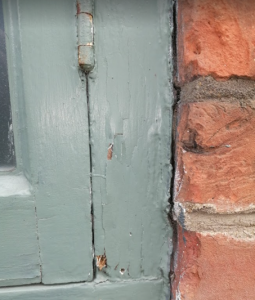Painting Timber Windows
 When you enquiry or do an internet search regarding painting timber windows, the first few steps commonly refer to the preparation of the wood itself. Many words are taken up by the care with which you should clean, sand, dust, remove handles and protect surfaces. Very little is ever said about the important of choosing the correct paint. This is unfortunate because rot can establish in timber windows when they have been decorated with the wrong paint.
When you enquiry or do an internet search regarding painting timber windows, the first few steps commonly refer to the preparation of the wood itself. Many words are taken up by the care with which you should clean, sand, dust, remove handles and protect surfaces. Very little is ever said about the important of choosing the correct paint. This is unfortunate because rot can establish in timber windows when they have been decorated with the wrong paint.
Modern paints for exterior woodwork are often Acrylic or Alkyd based. Basically, these synthetic paints are a plastic coating which traps moisture underneath paint it eventually becomes less flexible. When the paint eventually cracks, it allows the ingress of moisture. Flaking begins but the damage is already done. Moisture will have already started to rot the wood beneath.
This is made worse with each additional coat of paint. The more coats applied, the more moisture is trapped inside. Painting timber windows with modern paints can reduce their lifespan.
The alternative to these synthetics are linseed paints. Linseed oil has been a core component in the making of paint for centuries. Linseed oil was used as a carrier in what we know as ‘oil paints’ along with quantities of natural pigment, lead and turpentine. These paints were excellent for protecting timber from the elements and they lasted for decades. These traditional paints lost popularity due to the significant health risks associated with using lead in paint. The arrival of petrochemical paints and the hazards of using lead saw the demise of linseed paints in the first half of the 20th century.
Fortunately, we have recently seen a resurgence coming from the heartland of linseed paint, southern Sweden. Since the 1980’s, Sweden has done extensive research into the use of linseed paint on century-old buildings and how best to preserve the beautiful old structures for future generations. They found that linseed oil-based paints are more appropriate for external timbers. They are fully absorbed into the wood and have the flexibility to accommodate the seasonal expansion and contraction of the wood without cracking.
Derived from the cultivated flax plant, linseed oil is extracted from the plants seeds using a method called cold pressing. The newly pressed oil is called ‘cold-pressed raw linseed oil’ and is stored for about six months during which time any impurities separate and the clear pure oil can be drawn off. The performance of linseed is superior because the size of the molecules in the linseed oil are smaller than water. As a result, it penetrates deeper into the timber. This enables water to be expelled through a wicking action and draws moisture out like the wick in an oil lamp. During paint manufacture each pigment particle is fully coated with oil which does not hinder this penetrating action. It joins to the material forming a bond, making it denser and drying really hard. Therefore, painting timber windows with linseed paint means that they will not flake or peel and will have a longer life span.
The revival of linseed paint required a pigment to take the place of lead as natural ingredients are always more at risk of exposure and growth of fungus or mould. This is now attained by the addition of the safe pigment Zinc Oxide. Being manufactured from natural earth pigments, they are colourfast with some vibrant hues in the palette. The finish is of a low sheen or matt finish. When applied, the finish appears a little grainy because of the heavy pigment content. A high quality brush will disperse this well. The finish dries with a dull sheen and it becomes less apparent. In fact, no different in some cases to its synthetic equivalents.
When painting timber windows, the drying time is about the same for linseed oil paint as solvent-based based oil paint. However, as linseed oil dries by exposure to oxygen and UV-light, different weather conditions can change the drying times slightly.
Over time, linseed paint can fade due to the decomposition of the linseed oil in the paint. This is only superficial and maintenance is a simple wipe of the painted surface with a thin coat of linseed oil. Because of its natural ingredients it decomposes naturally, leaving no harmful waste residue.
Through the rediscovery of ancient wisdom, there is an alternative to modern paint products. Linseed paints have proven to be cost effective, are good for the environment and able to preserve timber windows as well as other wooden features.
Contact us if you wish to know more.

